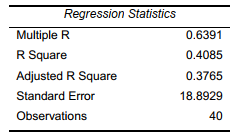SCENARIO 14-17
Given below are results from the regression analysis where the dependent variable is the number of weeks a worker is unemployed due to a layoff (Unemploy)and the independent variables are the age of the worker (Age)and a dummy variable for management position (Manager: 1 = yes,0 = no).
The results of the regression analysis are given below:

-Referring to Scenario 14-17,what is the p-value of the test statistic to determine whether there is a significant relationship between the number of weeks a worker is unemployed due to a layoff and the entire set of explanatory variables?
Definitions:
Current Ratio
A liquidity ratio that measures a company's ability to pay short-term obligations, calculated as current assets divided by current liabilities.
Current Liabilities
Short-term financial obligations that are due to be paid within one fiscal year or the operating cycle, whichever is longer.
Non-current Liabilities
Non-current liabilities are obligations a company owes that are not expected to be paid within the next twelve months, including long-term loans, bond payables, and deferred tax liabilities.
Current Assets
Resources anticipated to be turned into cash, disposed of, or used up either within a year or over the course of the operating cycle, depending on which period extends further.
Q6: Referring to Scenario 14-8,the value of the
Q15: Referring to Scenario 17-7,the "complete" method is
Q16: Referring to Scenario 17-2,which region has the
Q27: Referring to Scenario 13-4,the prediction for the
Q92: In testing for differences between the
Q96: Referring to Scenario 12-15,what is the value
Q157: Referring to Scenario 12-14,the rank given to
Q163: Referring to Scenario 14-15,there is sufficient evidence
Q167: Referring to Scenario 13-11,what is the p-value
Q210: Referring to Scenario 14-6,the value of the